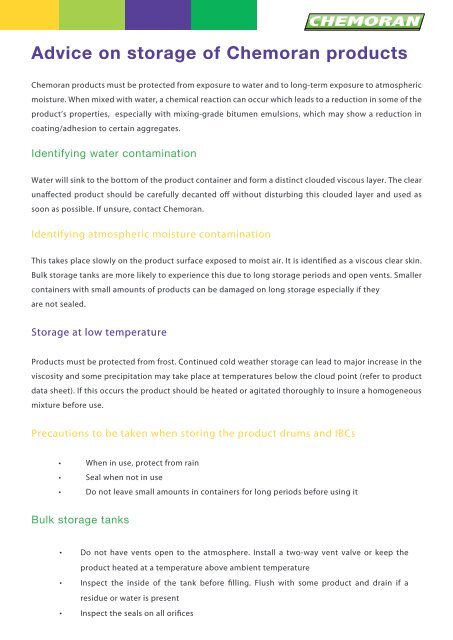DOWNLOAD - Chemoran Correct storage document
DOWNLOAD - Chemoran Correct storage document
DOWNLOAD - Chemoran Correct storage document
Create successful ePaper yourself
Turn your PDF publications into a flip-book with our unique Google optimized e-Paper software.
CHEMORAN<br />
Advice on <strong>storage</strong> of <strong>Chemoran</strong> products<br />
<strong>Chemoran</strong> products must be protected from exposure to water and to long-term exposure to atmospheric<br />
moisture. When mixed with water, a chemical reaction can occur which leads to a reduction in some of the<br />
product’s properties, especially with mixing-grade bitumen emulsions, which may show a reduction in<br />
coating/adhesion to certain aggregates.<br />
Identifying water contamination<br />
Water will sink to the bottom of the product container and form a distinct clouded viscous layer. The clear<br />
unaffected product should be carefully decanted off without disturbing this clouded layer and used as<br />
soon as possible. If unsure, contact <strong>Chemoran</strong>.<br />
Identifying atmospheric moisture contamination<br />
This takes place slowly on the product surface exposed to moist air. It is identified as a viscous clear skin.<br />
Bulk <strong>storage</strong> tanks are more likely to experience this due to long <strong>storage</strong> periods and open vents. Smaller<br />
containers with small amounts of products can be damaged on long <strong>storage</strong> especially if they<br />
are not sealed.<br />
Storage at low temperature<br />
Products must be protected from frost. Continued cold weather <strong>storage</strong> can lead to major increase in the<br />
viscosity and some precipitation may take place at temperatures below the cloud point (refer to product<br />
data sheet). If this occurs the product should be heated or agitated thoroughly to insure a homogeneous<br />
mixture before use.<br />
Precautions to be taken when storing the product drums and IBCs<br />
• When in use, protect from rain<br />
• Seal when not in use<br />
• Do not leave small amounts in containers for long periods before using it<br />
Bulk <strong>storage</strong> tanks<br />
•<br />
•<br />
Do not have vents open to the atmosphere. Install a two-way vent valve or keep the<br />
product heated at a temperature above ambient temperature<br />
Inspect the inside of the tank before filling. Flush with some product and drain if a<br />
residue or water is present<br />
• Inspect the seals on all orifices
Advice on <strong>storage</strong> and handling of GAP<br />
In addition to the general Advice on <strong>storage</strong> of <strong>Chemoran</strong> Products and the COLAS Technical Note n°120-A,<br />
it’s important to note the following:<br />
•<br />
•<br />
High viscosity at low temperature is inherent to the GAP emulsifier. This may cause a<br />
problem when pumping the GAP, especially at the beginning of the season, after<br />
continued cold weather <strong>storage</strong> over the winter months.<br />
GAP is more at risk to atmospheric moisture than other emulsifiers. It is known that the<br />
GAP emulsifier forms a viscous layer/skin when exposed to atmospheric moisture; the<br />
thickness depends on the length and temperature of the exposure. At low temperature<br />
this effect is more pronounced.<br />
Storage of GAP at low temperature<br />
•<br />
•<br />
•<br />
GAP must be protected from frost. Continued cold weather <strong>storage</strong> can lead to major<br />
increase in the viscosity of GAP<br />
GAP requires no reheating if pumped above 15-20°C.<br />
GAP at low temperature should not be continuously agitated or re-circulated back into<br />
its container unnecessarily.<br />
Protection against atmospheric moisture and water<br />
•<br />
•<br />
GAP must be protected from exposure to water and from long-term exposure to<br />
atmospheric moisture.<br />
Very little or no layer/skin forms on GAP in sealed containers, or if the GAP is maintained<br />
at 30°C or higher.<br />
<strong>Chemoran</strong> recommendations<br />
•<br />
•<br />
•<br />
•<br />
GAP needs to be protected from frost, and ideally maintained at a temperature 20°C or<br />
higher, during winter <strong>storage</strong>.<br />
When using GAP, its exposure to atmospheric moisture should be minimised.<br />
If GAP has developed a skin or a viscous layer, it should be heated to 30°C to<br />
re-homogenise the liquid before use.<br />
Stocks of GAP should be reduced over the winter months, unless it can be stored at<br />
temperatures of 20°C or higher.<br />
If you have any further queries, please do not hesitate to contact us through www.chemoran.com<br />
Revision n°1 (16/10/2012)












